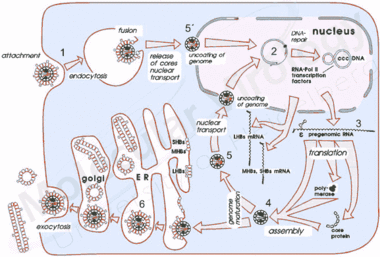Hepatitis B Virus
2. Replication
The intracellular steps of the hepadnaviral life cycle are understood in considerable detail, e.g. through use of heterologous systems such as cloned overlength genomes that allow to investigate one open round of replication, when transfected into cultured cells. These steps include attachment, endocytosis and fusion of the virus particle to hepatocytes (1), delivery of the released nucleocapsid to the nucleus (5), release and repair of the partially double stranded DNA genome by cellular enzymes (2), transcription and transport of pregenomic and subgenomic viral RNAs (3), translation of the pregenomic (core and polymerase) and subgenomic (surface proteins and X-protein) RNAs, encapsidation of the pregenomic RNA and the polymerase into RNA-containing nucleocapsids (4), reverse transcription into DNA containing particles that are either retransported into the nucleus (5) or enveloped and secreted as virions (6).
Fig.5: Replication cycle of HBV
In contrast to the intracellular replication steps, our knowledge of the early events of HBV infection -particularly receptor recognition, internalisation and membrane fusion- is rudimentary due to the relentless lack of a cell culture system until recently. In the past, these problems have been partially circumvented by the usage of primary hepatocytes from animal models e.g. the duck hepatitis B virus. Although primary human hepatocytes may be infected with HBV under strictly defined cultural conditions, their use as in vitro model is limited.
< Page 1 (Morphology & Genome) Page 3 (Cell Culture System) >
